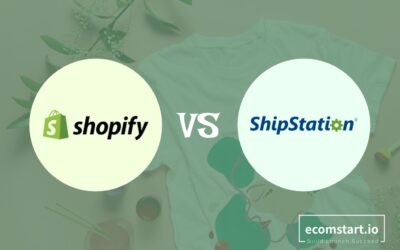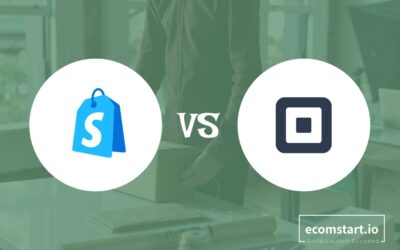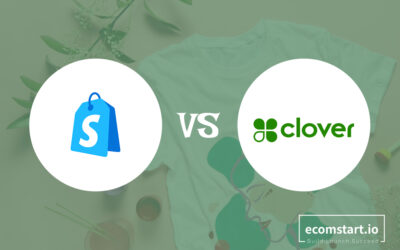Sellfy vs Shopify: An Unbiased Comparison With Pros & Cons
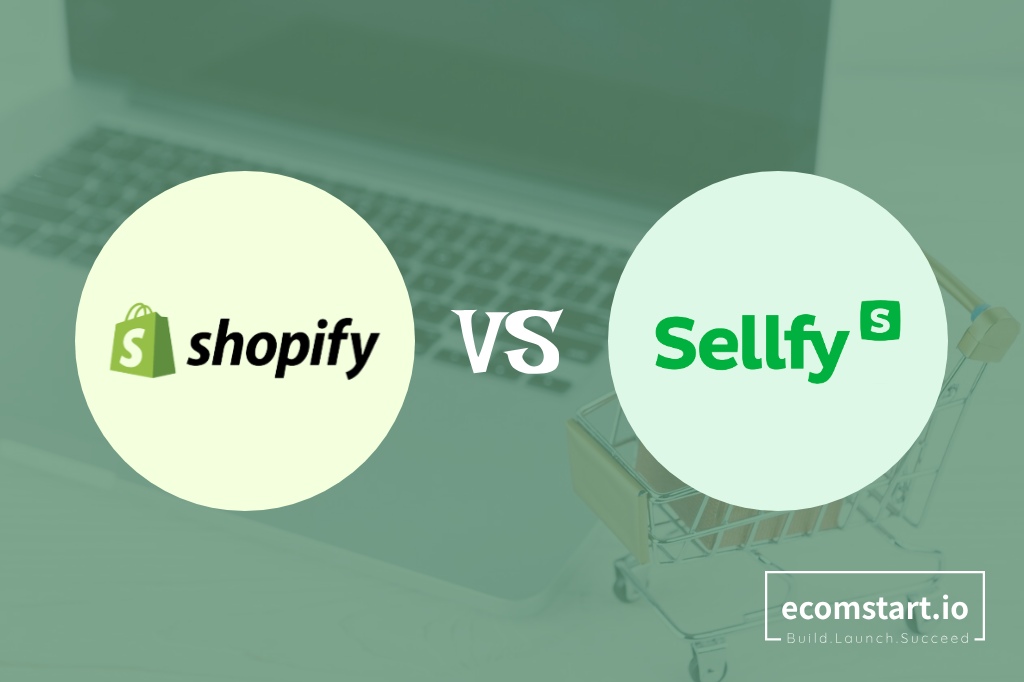
Although an online store’s success depends on countless factors, choosing the right platform for your eCommerce website can make all the difference. So, between Sellfy vs Shopify, which one is the right platform you are searching for?
Hint: It’s not that hard. If you intend to launch a scalable eCommerce store selling tangible products, Shopify is the right choice. Meanwhile, if you are a creative who wants to sell digital products and some merch, Sellfy can make so much sense.
In this article, we will compare Shopify vs Sellfy under important factors to help you pick the one that best suits your demand and budget.
Contents
1. A quick overview of Sellfy vs Shopify
Criteria | Sellfy | Shopify |
|---|---|---|
Definition | Sellfy is a platform built for creators and small businesses to sell digital products, physical goods, and subscriptions. | Shopify is an easy-to-use eCommerce platform with robust sales and marketing features. |
Rating on G2 | 3.9 (50 reviews) | 4.4 (4,520+ reviews) |
Pricing | 3 standard plans: $29 – $159/month 1 enterprise plan for stores exceeding $200k in annual sales | 3 standard plans: $39 – $399/month 1 starter plan: $5/month 1 enterprise plan: from $2,300/month |
Target audience | Digital creators like artists, writers, and musicians, as well as small businesses selling a few physical products. | Dropshippers and businesses of all sizes (largely small to medium ones). |
Design and customization | Provides basic store templates with limited customization options aimed at non-technical users. | Dedicated Offers extensive customization options through themes and advanced CSS/HTML editing capabilities.for B2B operations |
Ease of use | With a simple interface, Sellfy is a brilliant choice for beginners. | Like Sellfy, Shopify is famous for its ease of use and intuitive dashboard. |
eCommerce features | Basic eCommerce functionalities like a storefront, product listings, and the ability to accept payments with PayPal/Stripe gateway. | A comprehensive set of eCommerce tools including inventory management, payment processing, POS features, etc. |
Marketing tools | Basic tools such as discount codes and simple email marketing capabilities. | Extensive marketing tools including SEO features, email marketing, and integration with multiple sales channels. |
Apps and integrations | Selffy doesn’t have an app store. To integrate apps, you will have to use an integration platform like Zapier as a service (iPaaS). | Unlike Sellfy, the Shopify App Store has over 8,000 apps, with new ones added daily. |
Scalability | It is more suited for small-scale businesses due to limited advanced features. | Highly scalable, suitable for growing from a small store to a large enterprise. |
🔶 Similarities
- Sellfy and Shopify are both hosted platforms. You pay a recurring subscription fee (monthly or annually) to host and manage your online store on each platform.
- Both platforms are intuitive and easy to use, even for beginners.
🔶 Differences
With its fantastic built-in eCommerce feature suite, seamless POS integration, and extensive App Store, Shopify is trusted as the best eCommerce platform. This means if you want to build an online store with growth in mind, Shopify should be the way to go.
Though less popular, Sellfy is trusted by more and more digital creators and small businesses that focus largely on selling digital products.

2. Shopify vs Sellfy: A detailed comparison
2.1. Pricing
🔶 It’s a tie when weighing Sellfy vs Shopify cost.
If you just want a small online store to sell merch casually, Sellfy is a great choice. However, if you need to make the most of your money’s worth, Shopify is our recommended solution.
Plan type | Sellfy licensing fee | Shopify licensing fee | Sellfy transaction fee | Shopify transaction fee |
|---|---|---|---|---|
Starter/Basic Shopify | $29/month | $39 USD/month | None | 2.0% (if not using Shopify Payments) |
Business/Shopify | $79/month | $105/month | None | 1.0% (if not using Shopify Payments) |
Premium/Advanced Shopify | $159/month | $399/month | None | 0.6% (if not using Shopify Payments) |
Shopify Plus | Not available | $2,300/month | Not available | Negotiable based on volume |
Sellfy offers lower licensing fees across comparable plan types and does not charge any additional transaction fees, making it straightforward and budget-friendly, especially for smaller operations.
Shopify’s licensing fee is higher, and the platform charges additional transaction fees if you choose not to use Shopify Payments.
Nevertheless, Shopify justifies its higher cost through a robust suite of features tailored for businesses of all sizes. This includes extensive tools for inventory management, detailed analytics, and global selling capabilities. (we’ll discuss this later below)

2.2. Design & customization
🔶 Shopify wins.
Though Shopify’s design customization capabilities are not as extensive as open-source platforms, Shopify still offers you a deeper level of customization options than Sellfy.
Sellfy allows you to customize your storefront with basic design templates and simple, intuitive controls to adjust colors, fonts, and layouts.
Meanwhile, Shopify stands out with its vast customization capabilities. You can choose from a wide range of professionally designed themes and customize them to your brand style. The platform also supports advanced modifications through its rich app ecosystem and access to the underlying HTML and CSS.

2.3. Ease of use
🔶 Sellfy is more user-friendly.
Both Shopify and Sellfy are beginner-friendly. However, due to its vast feature offerings, the learning curve might be a bit steeper.
You wouldn’t want to spend hours in front of the computer screen struggling with technical stuff. Therefore, it’s important to choose a platform that doesn’t leave you with technical headaches.
Luckily, both Sellfy vs Shopify are intuitive and easy to use.
Sellfy is incredibly straightforward, featuring a drag-and-drop builder that simplifies the setup process. You can easily add products—both digital and physical—and the platform handles most of the technical aspects for you, such as payment integration and tax calculations.
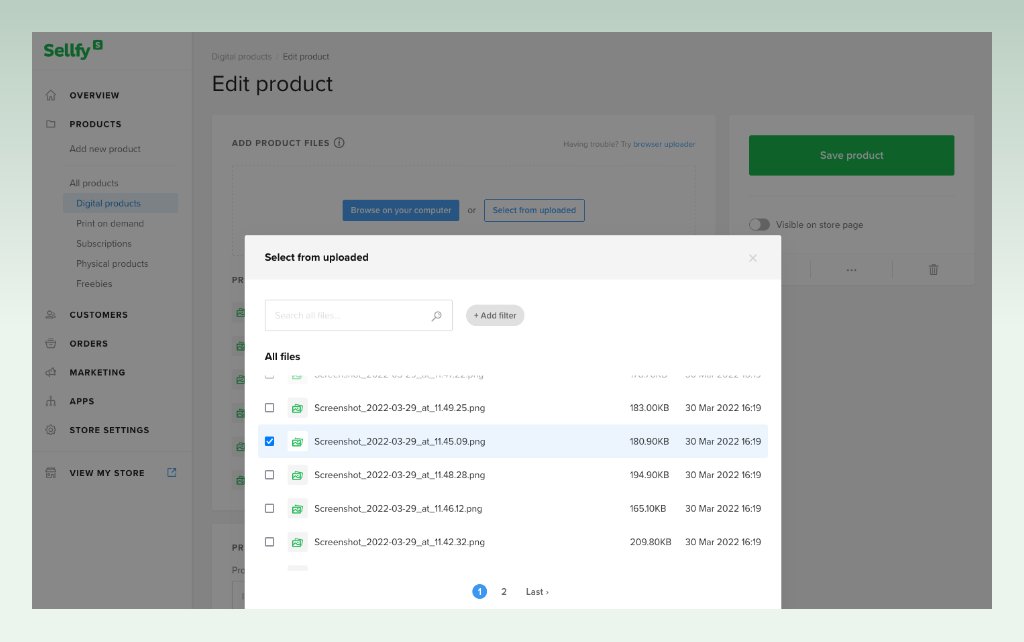
This ease of use makes Sellfy ideal for creators or small businesses that don’t require a highly customized storefront.
While user-friendly, Shopify offers more depth, which may involve a learning curve. It gives you extensive control over every aspect of your eCommerce operation, from managing inventory to enhancing your store’s SEO.
Although Shopify guides you through the setup with clear steps, maximizing its full range of features—like customizing themes using their Liquid code—can take some time to master.
2.4. eCommerce features
🔶 Another tie.
It boils down to what kind of products you plan to sell. If it’s physical products, Shopify is holding the winning hand. By contrast, Sellfy takes the crown if it’s digital product selling.
Feature | Sellfy | Shopify |
|---|---|---|
Payment gateways | Supports major gateways like PayPal, Stripe | Supports over 100 payment gateways including its own Shopify Payments |
Checkout customization | Limited customization | Extensive customization including checkout language and automated cart recovery |
Subscription sales | Supports selling subscriptions | You’ll need a third-party subscription tool |
Inventory management | Basic inventory tracking | Advanced inventory management with detailed insights and forecasting |
Shipping solutions | Integrates with major carriers | Comprehensive shipping solutions with discounts, real-time rates, and label printing |
POS (Point of Sale) | Basic POS functionality | Advanced POS solutions integrated across online and offline sales channels |
With simple payment gateways and basic subscription support, Sellfy is a good choice if you primarily sell digital items and want a hassle-free setup.
Shopify is better suited for selling physical products. Its wide range of eCommerce features supports a bigger business, especially if you sell offline. Shopify’s POS system works well both online and in stores, which is great for businesses with a physical presence.
2.5. Marketing tools
🔶 Shopify wins again.
Sellfy comes packed with good marketing tools, but compared to Shopify’s robust built-in marketing features, Sellfy is far behind.
Feature | Sellfy | Shopify |
|---|---|---|
Email marketing | Integrated email marketing tools | Advanced email marketing integrations |
SEO tools | Standard SEO capabilities | Enhanced SEO tools with more customization options |
Social media integration | Direct integrations with major social platforms | You’ll need Extensive integration and features for social media marketing third-party subscription tool |
Discounts and promotions | Effective tools for creating discounts and sales inventory tracking | Advanced inventory management with detailed insights and forecasting |
Shipping solutions | Integrates with major carriers | Dynamic engines for managing complex promotions |
Analytics | Comprehensive analytics for performance tracking | Detailed analytics with deeper customer insights |
Sellfy provides robust email marketing, efficient social media integrations, and comprehensive analytics to help you track your store’s performance.
Shopify offers a broader range of marketing tools that allow for a higher degree of customization and depth. This includes more advanced SEO options, sophisticated social media marketing tools, and detailed analytics for optimizing marketing strategies.
2.6. App & integrations
🔶 Shopify wins
The Shopify App Store has over 8,000 apps covering a wide range of features whereas Sellfy doesn’t even have an App Store.
No matter how robust your eCommerce platform can be, you’ll need the help of apps to add custom features to your store. Hence, app and integrations would be another factor we use to compare Sellfy vs Shopify.
Speaking of this matter, Shopify completely overshadows Sellfy. Shopify App Store has over 8,000 apps in all possible categories– finding products, upselling, etc.

Sellfy, on the other hand, doesn’t have an app store and if you want to integrate your Sellfy store with a third-party app, you need to use a connector like Zapier.
2.7. Scalability
🔶 Shopify is the winner.
With more flexible pricing plans and advanced, automatic features, Shopify is a brilliant choice if you want to scale up your online store effectively.
Shopify offers various pricing plans, ranging from the $29/month Basic Shopify plan to the $2,000/month Shopify Plus plan, making it easy to scale your business as it grows. It also includes advanced features such as automated shipping/fulfillment and Shopify Capital for business financing.
Conversely, Sellfy is more tailored for small businesses and creators, with plans up to $299/month for the Pro plan, which supports up to 10,000 orders per month. However, Sellfy might fall short of those requiring advanced inventory management and handling very large order volumes.
2.8. Support
🔶 Shopify defeats Selly in terms of customer support.
Shopify’s support system is more comprehensive and accessible, making it superior to Sellfy’s, which is more suited for merchants comfortable with less direct support.
Though Shopify and Sellfy are both easy to use, it is unavoidable to run into technical issues every once in a while. In those times, getting access to prompt and quality support can be a life-saver.
Hence, customer support is the last factor we’ll use to compare Sellfy vs Shopify.
Talking about Shopify, we believe the platform offers robust customer support available 24/7 via live chat, email, and phone, staffed by knowledgeable representatives. It has a comprehensive help center with guides, FAQs, and tutorials on a wide range of topics from setup to marketing, etc.

Sellfy’s support is more limited since it only offers email support with variable response times and lacks live chat or phone options. Nevertheless, we highly appreciate Sellfy for their effort in making video tutorials for their help center.
3. Shopify vs Sellfy: All the pros and cons
3.1. Pros and Cons of Shopify
- Extensive range of features and customization options
- Robust marketing tools and SEO capabilities
- Advanced inventory and shipping solutions
- Wide range of payment gateways
- Comprehensive customer support available 24/7
- Requires a steeper learning curve due to complexity
- Higher cost, especially for advanced features
- Additional fees if not using Shopify Payments
🔷🔷🔷 Choose Shopify if you want a scalable, feature-rich platform that grows with your store.

3.2. Pros and Cons of Sellfy
- Simple and quick setup, user-friendly interface
- Ideal for selling digital products directly
- No transaction fees
- Basic but efficient marketing and sales tools
- Limited customization and advanced feature options
- Less comprehensive customer support
- Smaller range of payment gateways and integrations
🔷🔷🔷 Choose Sellfy if you prefer a straightforward solution to sell digital products.
3.3. Our verdict
While Shopify stands out as the superior platform for businesses seeking scalability and extensive customization, Sellfy is more suitable for those seeking simplicity and efficiency.
Are you interested in Shopify and want to see how it stacks up against other eCommerce platforms? Our article on the 15+ best Shopify alternatives would make for a cool reading.
💡 Relevant article: Shopify vs PrestaShop: Which Platform Would Be the Best 2024?
4. Final thoughts
All in all, Shopify is the world’s famous eCommerce platform for a reason. It’s easy to use, has a fantastic suite of sales & marketing features, and an App Store of over 8000 apps.
Though not as popular, Sellfy is the go-to choice of many people, particularly digital creators who want to sell digital products online.
eComStart hopes after reading our comprehensive Sellfy vs Shopify comparison, you can now choose the one that best suits you.
Don’t forget to check out eComStart.io for more interesting eCommerce tutorials, tips, and tricks.

5. FAQs
Sellfy is better for selling digital products and subscriptions. While Shopify is great, it suits stores that sell physical products.
No, there are not. Both Shopify and Sellfy let you add unlimited products to your store no matter which
Yes, you can. However, if you want to sell physical products, Shopify is a much better option in all possible aspects thanks to its robust built-in eCommerce features and extensive App Store.
Sellfy is only better than Shopify if you want to sell digital products. This is because between Shopify vs Sellfy for digital products, Sellfy has more purposely built features for stores selling digital items.
Yes, both platform charges you a credit card processing fee. However, Shopify charges extra transaction fees if you choose not to use their own payment gateway.
Between Sellfy vs Shopify, Shopify offers way better marketing tools and integrations you need to promote and scale up your store effectively.




